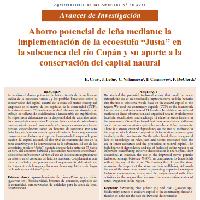Resumen
- Se analizó el ahorro potencial de leña a través de la implementación de la ecoestufa “Justa”, y los posibles beneficios sobre la conservación del capital natural de la zona. El marco conceptual empleado es el marco de los capitales de la comunidad (CCF). Se entrevistaron a 23 familias, se realizó observación dirigida y se trabajó en talleres de socialización e intercambio de experiencias. Se registraron diferencias en la disponibilidad de capitales entre las comunidades en estudio. Existe un factor cultural costumbrista muy arraigado para el consumo de leña, lo que ocasiona una fuerte presión especialmente sobre los bosques de coníferas. Por otro lado, hay un desconocimiento generalizado de leyes, reglamentos o normas vinculadas con el aprovechamiento del bosque o la protección del capital natural. El alto nivel de consumo de leña en la zona contribuye en la deforestación de la subcuenca. El uso de las ecoestufas, modelo “Justa”, permite ahorrar leña entre un 73 hasta un 89% del consumo habitual y las familias reconocen otros beneficios sobre su bienestar. Si bien el uso de las ecoestufas promueve un ahorro en el consumo de leña, es necesario complementar con otras actividades que promuevan el mejoramiento del estado de los fragmentos de bosques, y las zonas de recarga hídrica a lo largo de la subcuenca del río Copán.
- We studied the potential fuelwood saving that could be made through the use of an ecofriendly improved stove and the benefits that the use of this stove would have on the natural capital of the region. We used the community capitals (CCF) as the framework for our study and interviewed 23 families. In addition we utilized methods of direct observation, and organized several workshops to facilitate socialization and exchange of ideas between farmers in the community. Overall we found that there were distinct differences in the access to certain capitals by members of the community. There is a strong cultural dependency on the use of fuelwood in the region, which drives a important deforestation pressure, particularly on the pine forests. On the other hand, there is a general lack of knowledge on rules, laws and norms associated with the use of forest resources and the protection of natural capital. The high degree of dependency and use of fuelwood in the region is an important contributing factor to deforestation in the Copan River watershed. In contrast, the use of the improved stoves permits fuelwood savings between 73-89% in comparison to households without the use of the stove. The families that do use the stove recognize the impact of the stove on their well-being. Although the use of the stove is successful in promoting important savings in fuelwood consumption, its use must be complemented with other activities in the region that improve the conservation status of forest fragments in the region.
